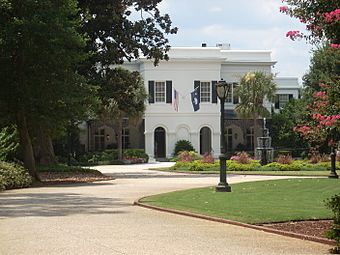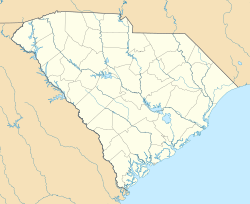South Carolina Governor's Mansion facts for kids
Quick facts for kids |
|
|
South Carolina Governor's Mansion
|
|
|
U.S. Historic district
Contributing property |
|
 |
|
| Location | 800 Richland St., Columbia, Richland County, South Carolina |
|---|---|
| Area | 9 acres (3.6 ha) |
| Built | 1855 |
| Architect | attributed to George Edward Walker |
| Architectural style | Federal; post-colonial |
| Part of | Columbia Historic District I (ID71000798) |
| NRHP reference No. | 70000597 |
The South Carolina Governor's Mansion is a special historic home in Columbia. It is the official place where the governor of South Carolina lives and works. This beautiful house has a classic Federal style, which was popular in the early days of the United States. It has a white outside made of stucco.
The mansion was built in 1855. It first served as housing for teachers at the Arsenal Academy, a military school. In 1865, during the American Civil War, much of Columbia was burned by soldiers. Amazingly, the Governor's Mansion was the only building from the academy that survived! Because it was still standing, it became South Carolina's official governor's home in 1868. Today, it is surrounded by lovely magnolia trees, elm trees, and oak trees. A circular driveway leads to the main entrance, which has a fountain. The mansion has 15 rooms, not counting offices or the kitchen. It is a very important part of South Carolina's history. The mansion is currently home to Governor Henry McMaster and his family.
Contents
History of the Governor's Home
Early Years: The 1800s
We don't know for sure who designed the mansion. However, many believe it was George Edward Walker, who designed other buildings nearby. The mansion was originally built as housing for officers at the Arsenal Military Academy. In 1865, during the Civil War, the city of Columbia was burned by the Union Army. The mansion was the only building left from the military academy.
In 1868, Governor James L. Orr decided this building would be the official home for future governors. The next year, some money was spent to make the house ready. But the money ran out before the work was finished. Because of this, Governor Robert K. Scott had to move into a house that wasn't quite ready.
Since 1868, only three governors have chosen not to live in the mansion. They stayed in their own homes in Columbia instead. One governor, Daniel Henry Chamberlain, likely lived elsewhere because the mansion needed repairs. For a time, the state even rented out the official residence to a family who used it as a boardinghouse. Later, in 1886, Governor John Peter Richardson III gave money to make important changes to the building.
Changes in the 1900s
By the late 1940s, the mansion had some serious problems with its structure. Repairs finally began in 1955. This meant Governor George Timmerman and his family had to move out for a year. During Governor Donald S. Russell's time, the mansion got many improvements. These included new landscaping, a driveway, and a walled courtyard. The building's structure was also made stronger, and the inside was completely redone.
Later, Governor Ernest F. Hollings added a new guest wing and a family dining area. Governor Robert E. McNair created a special committee to help furnish the mansion. This committee, led by his wife Josephine McNair, found many items related to South Carolina's history and culture. In 1968, the committee bought the nearby Lace House. This created the Governor's Mansion Complex. In 1970, the state government gave the committee power to approve any improvements to the complex.
In 1977, Ann Edwards, the governor's wife, started the Governor's Mansion Foundation. This group raises money to help pay for the mansion's historic furniture. Around the same time, another nearby house, the Caldwell-Boylston House, was bought. These extra buildings now provide offices and space for meetings and events. By 1986, all three buildings were connected by a landscaping project. This created a large, nine-acre complex.
More structural problems were found in 1988. However, plans for new renovations took a while to start. During Governor Carroll A. Campbell's time, a new guardhouse and a second fountain were added. A big renovation project began when David M. Beasley was governor. It was finished in 2001 and cost over $6 million. Governor James H. Hodges was the first governor in 120 years not to live in the mansion when he took office in 1999.
The Mansion in the 2000s
In 2003, Governor Mark Sanford announced that the mansion would need to close for several months. This was due to a budget shortage. Governor Sanford explained that the state could not afford to pay for the mansion's staff, utilities, and food. He also mentioned that changes in staffing had increased costs.
To help the mansion stay open, a supporter named John Rainey started a special fund. A local company, Adluh Flour, even donated food like grits to the governor. In 2008, improvements were made to the building to help it use less energy.



